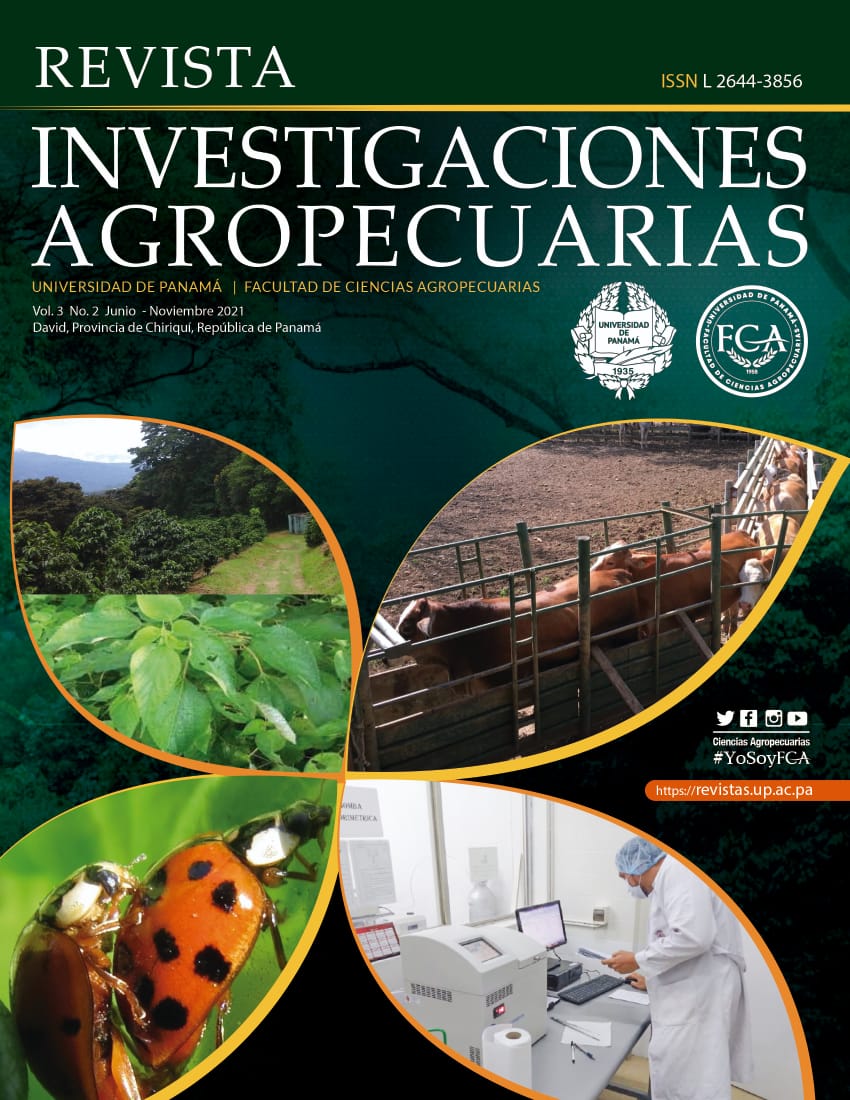References
Aguilar, P. (1980). Apuntes sobre el control biológico y el control integrado de las plagas agrícolas en el Perú. Revista Peruana de Entomología, 23(1), 83-110.
Aguilar, P. (1988). Las arañas como controladores de plagas insectiles en la agricultura peruana. Revista Peruana de Entomología, 31, 1-8.
Altieri, M., & Nicholls, C. 2010. Diseños Agroecológicos para Incrementar la Biodiversidad de Entomofauna Benéfica en Agroecosistemas. Primera Edición. Sociedad Científica Latinoamericana de Agroecología (SOCLA), Medellín, CO. 83 p.
Benamú, M. (1999). Estudio preliminar de la araneofauna presente en mandarina cultivada en Vitarte, Lima, Perú. Revista Peruana de Entomología, 41, 154-157.
Carson, R. (1962). Silent Spring. Edición del 50 Aniversario. Mariner Books, US. 378 p.
Castillo, P., & Miró, J. (2013). Coccinéllidos en cultivos de Tumbes. Universidad Nacional de Tumbes. Facultad de Ciencias Agrarias. 104 p.
Cisneros, F. (2010). El Manejo Integrado de Plagas. Control de Plagas Agrícolas, Fascículo 13. 35 p. Recuperado el 12/09/2020 de: https://hortintl.cals.ncsu.edu/sites/default/files/articles/Control_de_Plagas_Agricolas_MIP_Ene_2010.pdf
Cisneros, F. (1995). Capítulo 8: Control Biológico. En F Cisneros, Control de Plagas Agrícolas (pp. 102-147). Segunda Edición. Full Print s.r.l., La Molina, Lima, PE.
Collantes, R., Perla, D., Rodríguez, A., Beyer, A., & Altamirano, J. (2016). Acacia horrida (L.) Willd.: Refugio de artrópodos benéficos en la costa peruana. Saber y Hacer, 3(1), 37-47.
Collantes, R., & Rodríguez, A. (2015). Diversidad de avispas parasitoides (Hymenoptera) en agroecosistemas de palto (Persea americana Mill.) y mandarina (Citrus spp.) en Cañete, Lima, Perú. Aporte Santiaguino, 8(2), 207-218.
Duarte, F. (2012). El control biológico como estrategia para apoyar las exportaciones agrícolas no tradicionales en Perú: un análisis empírico. Contabilidad y Negocios, 14, 81-100.
Fischbein, D. (2012). Introducción a la teoría del control biológico de plagas. En J Villacide y J Corley (Eds.), Serie Técnica: Manejo Integrado de Plagas Forestales, Cuadernillo No. 15. Instituto Nacional de Tecnología Agropecuaria (INTA), Bariloche, AR. 21 p.
González, G. (2007). Los Coccinellidae de Perú, recuperado el 03 de julio de 2015, de http://www.coccinellidae.cl/paginasWebPeru/Paginas/InicioPeru.php
Guanilo, A., & Martínez, N. (2009). Biología y comportamiento de Amblyseius chungas Denmark & Muma (ACARI: PHYTOSEIIDAE) como predador de Panonychus citri (McGregor) (ACARI: TETRANYCHIDAE). Ecología Aplicada, 8(2), 15-25.
Hanson, P., & Gauld, I. (Eds.). 2006. Hymenoptera de la Región Neotropical. Memoirs of the American Entomological Institute 77: 994p.
Herrera, J. (2010). Primera experiencia a nivel mundial del Manejo Integrado de Plagas: el caso del algodonero en el Perú. Rev. Per. Ent. 46(1): 1-8.
Hoddle, M., Robinson, L., & Virzi, J. (2000). Biological control of Oligonychus perseae (Acari: Tetranychiidae) on avocado: III. Evaluating the efficacy of varying release rates and release frequency of Neoseiulus californicus (Acari: Phytoseiidae). International Jouranl of Acarology, 26(3), 203-214.
Iannacone, J., & Perla, D. (2011). Invasión del depredador Harmonia Axyridis (Coleoptera: Coccinellidae) y una evaluación del riesgo ambiental en el Perú. The Biologist, 9(2), 213-33.
Jocqué, R., & Dippenaar-Shoeman, A. (2006). Spider Families of the World. Royal Museum for Central Africa. Tervuren, BE. 336 p.
Julca, A., Rodríguez, P., Meneses, L., Blas, R., Bello, S., Anahul, J., Crespo, R., Castañeda, E., Reynoso, A., Schuller, S., Fundes, G., & Santibañez, R. (2006). Selección de fuentes naturales para la fertilización de café en el marco de una agricultura orgánica. Línea base de Proyecto financiado por INCAGRO, en alianza con la UNALM, la FDA, la JNC y el INIEA. 53 p.
Korytkowski, C. (1967). Diplazon laetatorius (Fabr.) (Hym.: Ichneumonidae), Ichneumonido Syrphidófago poco conocido en el Perú. Revista Peruana de Entomología, 10(1), 54-58.
Landis, D., Menalled, F., Lee, J., Carmona, D., & Pérez-Valdez, A. (2000). Habitat modification to enhance Biological Control in IPM. En G Kenedy y T Sutton (Eds.), Emerging technologies for Integrated Pest Management: Concepts, Research and Implementation. APS PRESS. ST. Paul, Minesota. pp. 226-239.
León, G. (2005). La diversidad de insectos en cítricos y su importancia en los programas de manejo integrado de plagas. Manejo Integrado de Plagas y Agroecología (CR) 74: 85-93.
León, G. (2012). Insectos de los cítricos. En Corporación Universitaria Lasallista (Eds.), Cítricos: cultivo, poscosecha e industrialización. Capítulo 5 (pp. 129-161). Serie Lasallista Investigación y Ciencia. Ministerio de Agricultura y Desarrollo Rural, CO. CORPOICA. Universidad de Antioquía. 367 p.
Lozano, M., & Argumedo, J. (2012). Identificación de enemigos naturales de Diaphorina citri Kuwayama (Hemiptera: Psyllidae) en el Estado de Yucatán, México. Fitosanidad, 16(1), 5-11.
MINAGRI (Ministerio de Agricultura y Riego, PE). (2015). Consolidado de la Información Agraria de la Provincia de Cañete, diciembre de 2014. Oficina de Información Agraria, Agencia Agraria de Cañete.
Muñoz, J., & Rodríguez, A. (2014). Ácaros asociados al cultivo de aguacate (Persea americana Mill.) en la costa central de Perú. Agronomía Costarricense 38(1): 215-221.
Núñez, E. (1989). Chrysopidae (Neuroptera) del Perú y sus especies más comunes. Revista Peruana de Entomología, 31, 69-75.
Quispe, R. (2012). Áreas de refugio para el mantenimiento de enemigos naturales en el fundo “La Molina”, de la Universidad Nacional Agraria La Molina. Tesis para optar el título de M. Sc. en Entomología, UNALM. La Molina, Lima, PE. 157 p.
Ripa, R., Larral, P., & Rodríguez, S. (2008). Capítulo 4: Control biológico. En R Ripa y P Larral (Eds.), Manejo de plagas en paltos y cítricos (pp. 61-68). Instituto de Investigaciones Agropecuarias, Ministerio de Agricultura, CL.
Salazar, J. (1999). Control de plagas de los cítricos. Primera edición. SENASA, PE. 102 p.
Schowalter, T. (2011). Insect Ecology: An Ecosystem Aproach. Tercera Edición, Academic Press, US. 633 p.
Triplehorn, C., & Johnson, N. (2005). Borror and DeLong's lntroduction to the Study of lnsects. Séptima edición. Thomson Brooks/Cole, USA, 864 pp.
Val, E., & Boege, K. (2012). Ecología y evolución de las interacciones bióticas. FCE, MX. 275 p.
Valdivieso, L. (2011, 25 de abril). Control al natural. El Peruano, pp. 12-13. Recuperado el 05 de febrero de 2016, de http://issuu.com/mabelcalle/docs/20110424

